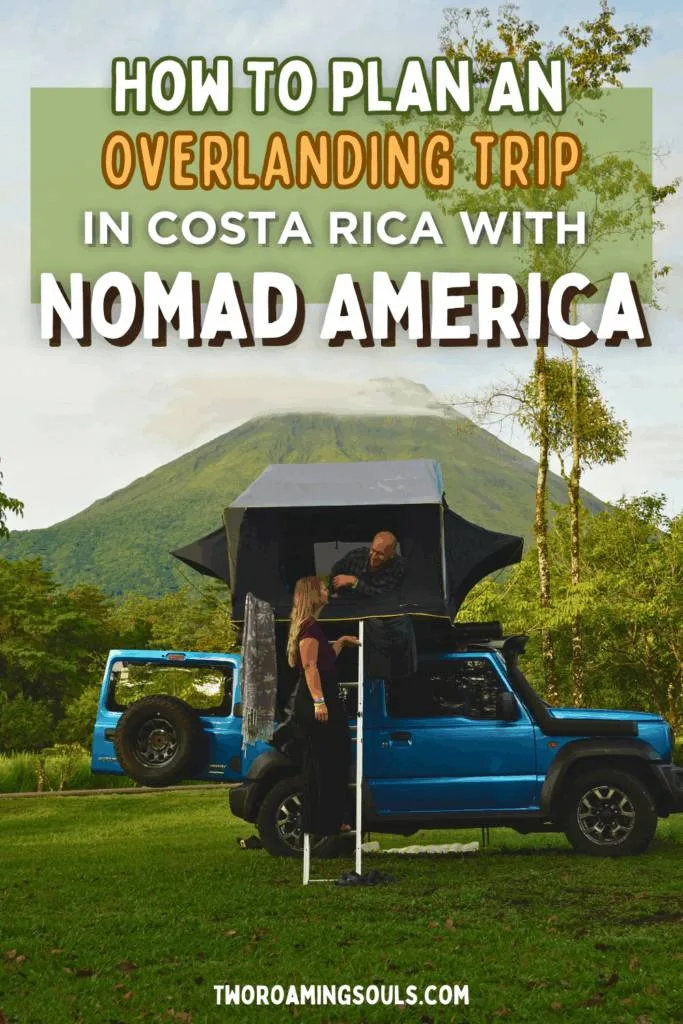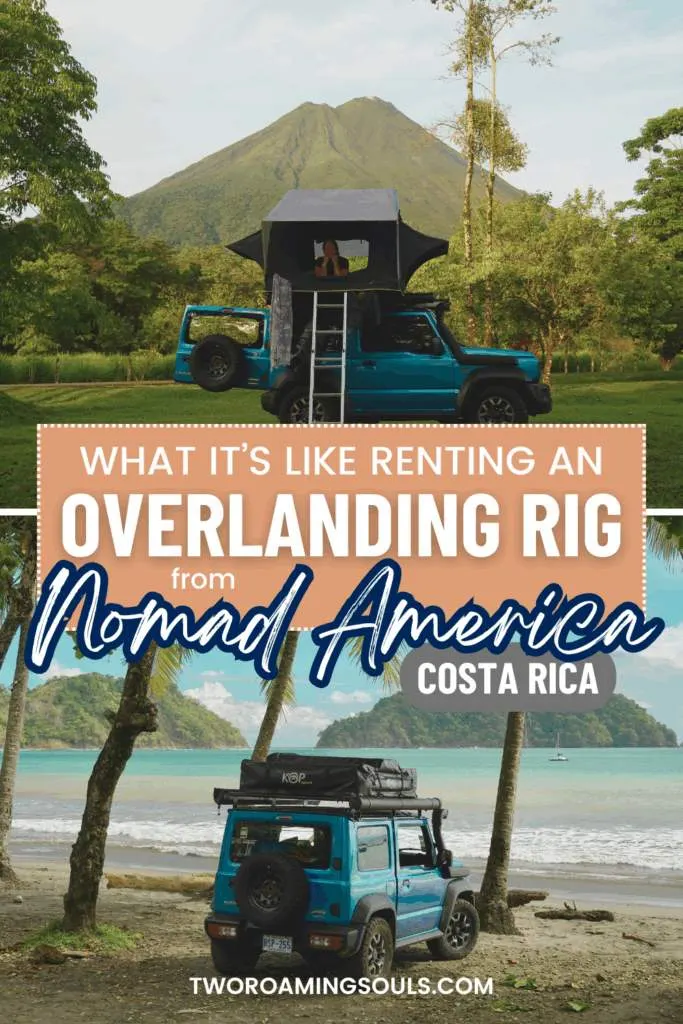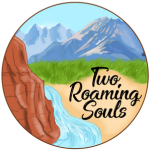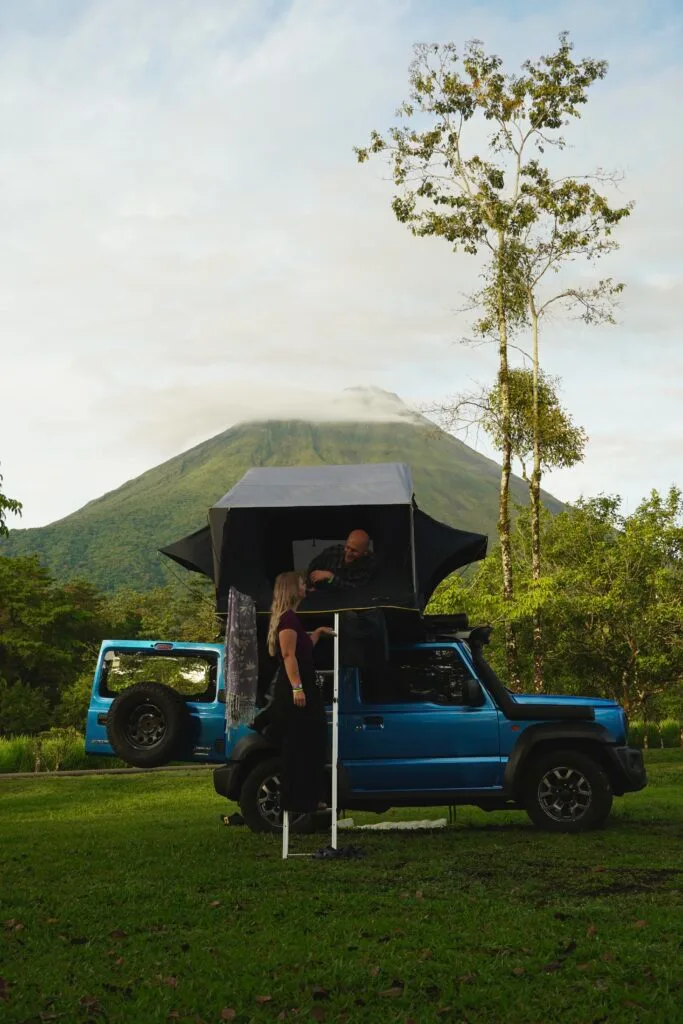
Ever dream of camping in Costa Rica? In this guide, we are going to share our experience doing a two week camping trip in Costa Rica with Nomad America.
For this adventure-packed trip we rented a 4-wheel drive vehicle with a rooftop tent from Nomad America. And we spent 2 weeks camping all over this beautiful country, from the mountains to the beaches. Costa Rica is full of incredible sights, tons of wildlife, and camping was certainly a good way to immerse ourselves in all this country has to offer.
But camping here certainly didn’t come without its challenges. So this guide will share our tips for doing your own Costa Rica camping trip, how to choose campsites, what to bring, and more.
The company we rented from, Nomad America, has a fleet of rad overloading vehicles for rent. And so this guide is partially a review of our experience renting from them, and also covers just more general information about camping in Costa Rica.
Costa Rica is known for having some pretty rough roads, especially the further you get from the main highways and cities. So having a 4×4 vehicle with high clearance is very helpful, or sometimes downright essential, depending on the road conditions or the destination.
Renting From Nomad America
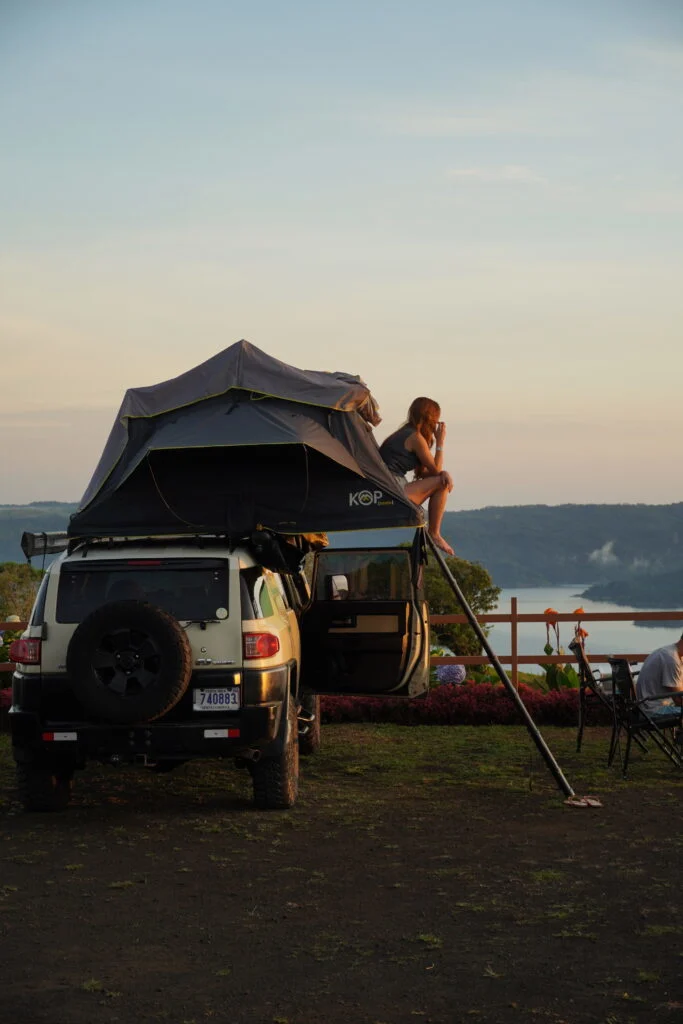
Renting an overlanding/camping rig with Nomad America is super easy and seamless.
First, you should browse the different camping vehicles they offer. All of their vehicles are 4×4 (except the Suzuki APV Campervan), and are broken down into different size categories: small, medium, and large. All rigs come with camping equipment, and most come with a roof-top tent for sleeping. (There are two rigs offering different sleeping arrangements).
The small rigs are compact and good for 1-2 travelers. There are really only two seats available once all the camping gear is loaded. (Our Jimny had the rear seats removed.) You have the option of a Toyota Prado or Suzuki Jimny (or similar).
The medium rigs offer slightly more space and room to add extras, such as surfboards, kayaks, luggage, etc. You have the option of a Toyota Hilux, Nissan Xterra, or FJ Cruisers (or similar). Nomad America can also provide extra camping equipment to suit up to 5 people.
Lastly, the large rigs can accommodate 5 people more comfortably and have more room for extra add-ons. You can choose between a Land Rover Defender or Jeep Wrangler (or similar). These rigs come with mud-terrain tires, and OME suspension. The large rigs are a little more rugged for off-road driving. (Note: The Land Rover Defender can fit up to 9 people!)
Additionally, there is the Kia 4×4 Truck Camper, which has a hard shell camper in the truck bed (note: it only comes in a manual transmission). It only sleeps 2 in the camper, but there is the option to add on 2 rooftop tents. The front cab can seat up to 6 passengers. If you are looking to go off-roading heavily, this is the most capable rig.
And the Suzuki APV Campervan is a minivan-style camper. This is their only rig without 4×4. There is a bed set up inside the van, and the kitchen pulls out in the back.
How To Book With Nomad America
You can research and book a rental right on their website. Once you find the rig you want to rent, enter the dates you wish to rent the rig. (Note: you MUST rent for 5+ days).
Do note that they offer both automatic and manual transmissions. So if you don’t know how to drive manual, then make sure you request an automatic.
Once you are ready to book, head to the booking page (by clicking book now). Here you will notice a mandatory third-party liability insurance, collision damage waiver, cleaning fee, and 13% tax fees. There is optional 100% tire & window insurance coverage, on-board wifi, and the option to add a driver. Then add in all your personal details below.
A 20% deposit is required to finalize the booking. Once you continue, you will be promoted to pay Nomad America via PayPal. The other 80% is due upon arrival. Plus a $1000 security deposit.
And we were very impressed with their communication throughout the process. But you need to have WhatsApp since that is the primary way they will communicate with you.
Flying Into San Jose Airport & Picking Up Your Rig
The Nomad America office is located about 20 minutes from the Juan Santamaria International airport in San Jose, Costa Rica’s capital city. And they provide a free shuttle to and from the airport.
Once you get to their office, they give a thorough demonstration on how everything works. We have camped plenty of times, but rooftop tents were completely new to us. So we were happy their staff took the time to really show us how to set everything up until we felt comfortable.
Depending on where you are traveling from, you may want to fly into San Jose a day early, or take a really early flight to make sure you arrive with enough time to get acquainted with your rig and get to your first camping destination.
Something that doesn’t really work in your favor is that the sunset is really early in Costa Rica. Year-round the sun always sets between 5 and 6pm.
We flew into San Jose around noon, and getting through customs, learning about our new rig, and grabbing a few groceries, barely left us enough time to set up at dusk and cook in the dark.
What Does Nomad America Provide?
Nomad America provides nearly everything you need to hit the road.
Rooftop Tent (Sleeping Area)
- Mattress
- Blankets
- Pillows
Camping Kitchen Set Up
- Camp Stove (w/ butane canisters)
- Cooking Utensils (including a sharp knife)
- Plates & Silverware
- Cutting Board
- Pots and Pans
- Cups and Mugs
- Coffee Maker (both Costa Rican style & Other: Aeropress or Percolator)
- Soap/Sponge
- Water Jug
Additional Items
- 2x Flashlight/Lanterns
- 2x Hammocks
- Table
- 2x Chairs
- AC/DC Charger
- Machete
- Shovel
- Portable Fan
- Rooftop Shower
- Awning
Extra Add-Ons (for an additional price)
- ARB Electric Fridge
- Surfboards
- Boogie Boards
- Portable Wifi
- Snorkeling Gear
- Fishing Gear
- GPS
- Additional Camping Gear
Items Not Included (But we suggest bringing, or buying there)
- Toilet Paper
- Paper Towels
- Headlamps
- Phone Mount For Car (seems insignificant, but driving with GPS directions hands-free was such a game changer)
- Travel Coffee Mugs with closing lid (so you can make coffee and get on with your day, even if that means driving some crazy dirt roads)
So, despite being a camping trip, you really don’t need to bring that much besides your normal trip packing list.
Tip: try not to bring a hard-sided suitcase; rather, bring a backpack and/or duffle bag, so you can easily store it in the vehicle.
Finding Campsites
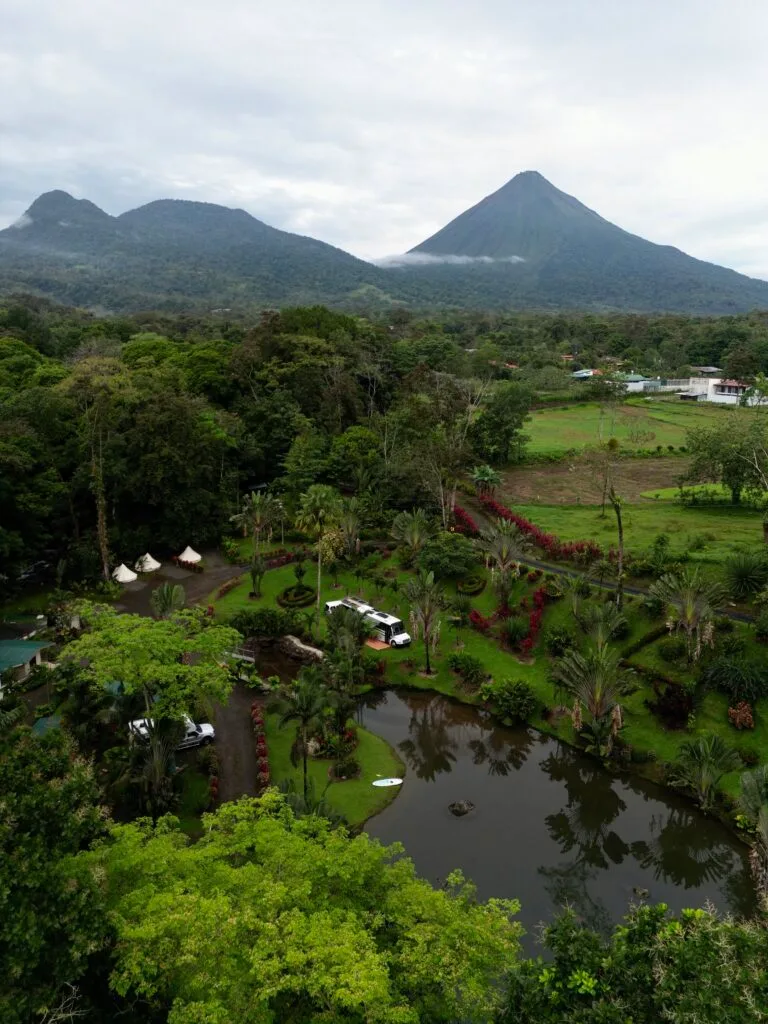
One of the most important parts of doing a trip like this is figuring out where to camp. The two main options are paid campsites or wild camping.
Paid campsites include things like bathrooms, showers, drinking water, trash, and sometimes electric hookups, a shared kitchen, and other nicer amenities.
Whereas wild camping is really just finding a place to park where you won’t bother anyone. And of course, there are no amenities of any kind.
And other benefits of paid campgrounds are that there is usually a bit of added security, which is nice to have for keeping you and your belongings safe.
Nomad America shared a website called Costa Rica Campsites that has a variety of recommended campsites, where you can receive discounts as a Nomad America customer. (But honestly, we totally forgot about this nice perk and never asked any hosts for a discount.) They also have an interactive map on their site that shows the whole country and all their recommended campsites, which I sometimes found easier to use.
Or you can also search for camping on Google Maps. Or lastly, we use an App called iOverlander 2. Which is a paid app that shares campsites, wild camping, water fill-ups, WiFi, or anything else that might be helpful to travelers. (But with the free version of the app, you can still download one country for offline use.)
For our trip, we did a combination of the two, but the majority of our nights were at paid spots, with prices that ranged between $6-15 per person, per night. So for the two of us, we were spending an additional $12-30 per night on camping.
We were definitely hoping to save money by doing mostly wild camping. But a number of factors guided us towards more paid options.
For starters, wild camping in Costa Rica isn’t like what we are used to in the western US. Instead of sanctioned dispersed camping areas where you know you are allowed to be there, Costa Rica wild camping is more like finding a random spot and hoping nobody cares that you are there.
We used iOverlander to find wild camping locations. And everything is user-submitted, so you don’t actually know for sure how viable a spot is. Hopefully, there are recent positive reviews, but even still, that’s not a guarantee of a peaceful night of sleep.
Being in a foreign country and camping somewhere without certainty that it’s allowed just left us feeling a little uneasy.
And on top of that, various wild camping spots, especially along the coast, had reviewers warning that they got robbed. Sometimes from years ago, or some more recently. And we especially travel with lots of expensive camera gear and laptops. And that made us uneasy as well.
So despite it seeming like there are lots of wild camping spots, in actuality, we didn’t end up finding much wild camping that we felt comfortable with, or fit into our itinerary.
Tip: In our Costa Rica guides below, we include specific campgrounds we suggest in each location.
And lastly, I want to mention that we did end up booking a few nights in hotels along the way, for various reasons (ie: rain, price of camping vs cheap hotel, laundry, hot shower, etc.)
Where Should You Go In Costa Rica?
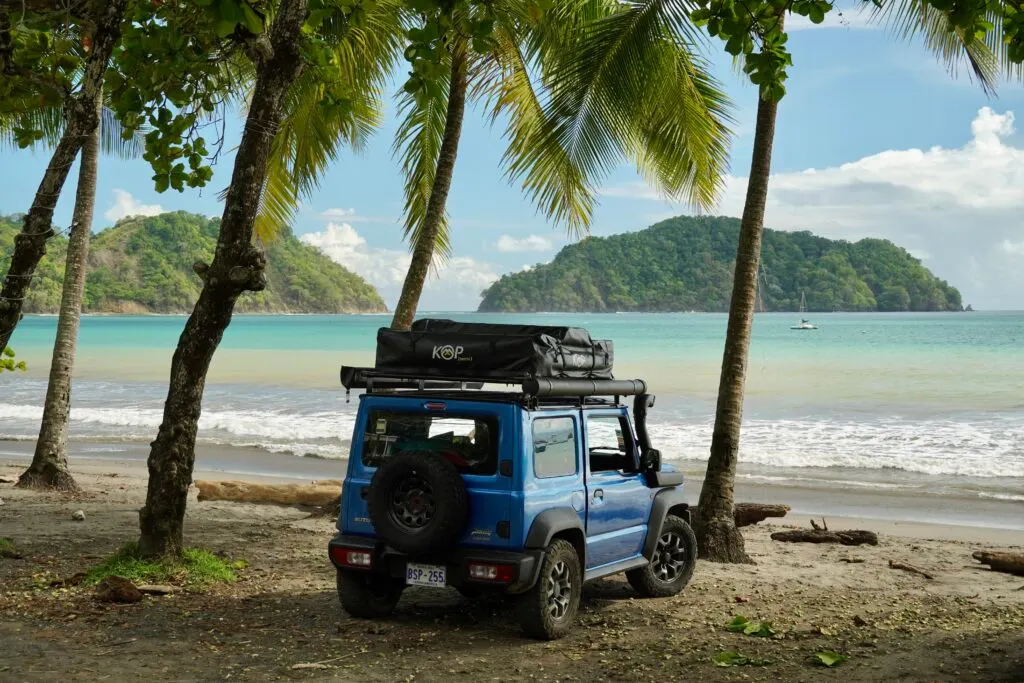
Costa Rica is full of amazing places to visit, with tons of variety. So choosing where you want to go depends on your interests and how much time you have.
Here’s A Brief Overview Of The Country:
Costa Rica has two coastlines, the Caribbean side and the Pacific side. And down the interior of the country are a variety of mountain ranges and volcanoes.
The Caribbean side is known for calmer waters, better snorkeling and diving, and a more Caribbean island vibe.
The Pacific side has bigger waves with beach towns that are much more surfing-oriented. But some more protected beaches do provide some good swimming conditions.
The interior mountains are known for volcanoes, waterfalls, hiking, coffee farms, adventure tours, wildlife, and more.
And when it comes to wildlife, the places with the most biodiversity tend to be in the mountainous interior and the central and southern Pacific Coast.
The capital of San Jose, is the largest city in Costa Rica, and the best place for the most cosmopolitan side of Costa Rica, like architecture, culture, art, and more. Since you are considering a camping trip in Costa Rica, I’m guessing you’re probably like us, and would rather explore nature than the city.
For our two-week trip, we landed in San Jose, spent about the first half of our trip in the mountainous interior, and then the second half was spent along the central and southern Pacific Coast.
Our Adventurous Costa Rica Itinerary:
- La Fortuna for 4 days
- Rio Celeste for 1 day
- Monteverde for 3 days
- Uvita for 4 days
- Dominical for 2 days
- And Manuel Antonio for 1 day
So even with two weeks, there are entire popular regions of Costa Rica that we didn’t see.
Places like the Guanacaste Province, the Osa Peninsula, and the entire Caribbean side.
Here are some travel guides for the places we visited (including campsite recommendations):
- Best Things To Do In La Fortuna
- Top Restaurants In La Fortuna
- Best Things To Do In Monteverde
- Best Things To Do In Uvita
- Best Things To Do In Dominical
Personally, I think our itinerary was aggressively packed, but mostly because we set pretty ambitious goals to create lots of content for this blog and our YouTube Channel. You could easily travel a little slower, with less time spent driving and more leisure time at each destination.
What It’s Like Driving In Costa Rica
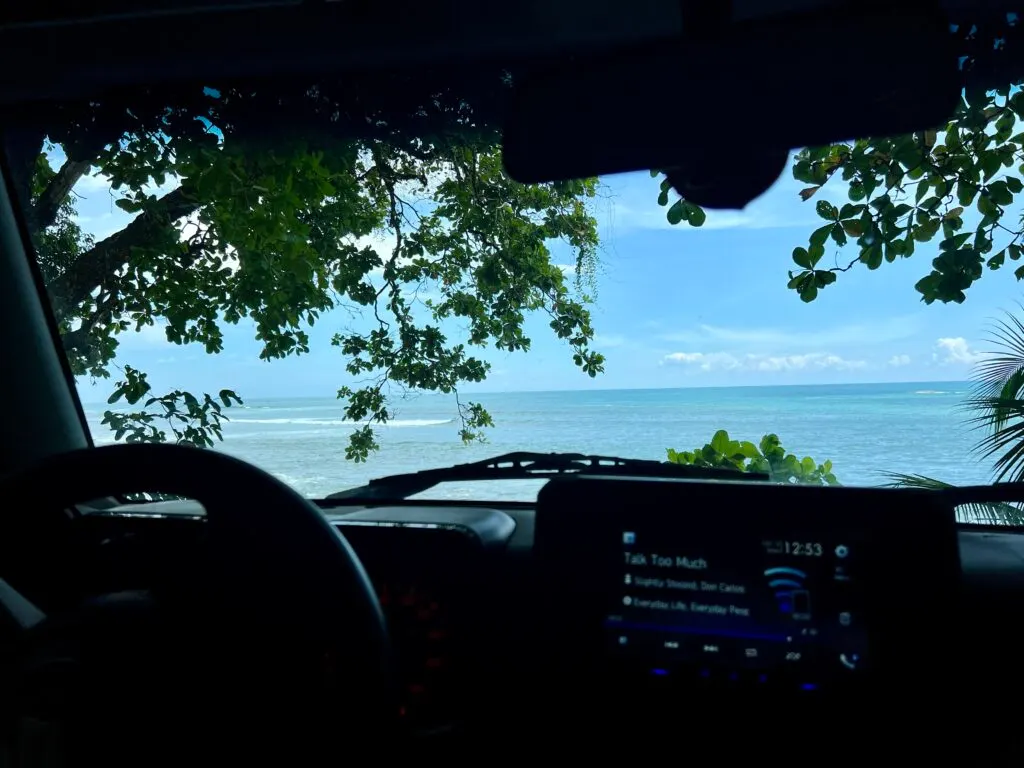
Depending on who you ask, you will get very different answers about what it’s like driving in Costa Rica. And that’s probably because it’s all relative to your experience.
But overall, I didn’t find the driving in Costa Rica to be that intimidating. For starters, driving on the right side of the road is familiar to me. And at least on the primary routes, nothing felt too crazy. Like lanes were generally painted clearly, there are appropriate stop lights and other safety signage.
And more importantly, people were typically obeying the traffic rules and customs that I am used to.
The signs are in Spanish, so it’s not a bad idea to brush up on some of the most common signs if you can’t read Spanish. Expatden has a good blog post with a visual of important signs, and other driving tips. But even without reading, the shapes and icons of signs should be enough to convey their meaning.
The only thing that might be nerve-racking is the amount of passing in the oncoming lane that locals do. And the high number of motorbikes that are sometimes hard to keep track of.
But the real challenges of driving in Costa Rica begin once you get off the primary roads. Generally, the more mountainous the terrain, the more treacherous the roads can be. And this can be exacerbated by heavy rains, which can make otherwise fine roads feel dangerous to drive.
But again, I’ve got lots of experience driving mountain roads in a vehicle much bigger and less capable than the Jimny.
You need to stay very alert when driving in Costa Rica. Assume that there could be wildlife, potholes or rough roads at any moment. And some routes might even have unexpected river crossings. Like for example, the backroads from La Fortuna to Monteverde have one such river crossing. But we didn’t take that route.
Common sense is to scout any river crossings on foot and don’t cross any river that is showing signs of change or potential flash flooding. Yeah I know the Nomad America rigs come with engine snorkels, but they instructed us not to cross any river higher than halfway up your tires. So, like most vehicle snorkels I’ve seen, they are really just for show.
The only incident of our trip was very easily avoidable in hindsight. We were in the mountains of Monteverde and foolishly tried to drive up a really steep, muddy road in a rainstorm. We were being cheap and avoiding paying for a campground. And we knew just how steep that road was, because we had driven it dry the night before. But in the rain, we ended up backsliding into a ditch, and proceeded to spend the next 20 minutes trying to get unstuck.
I do wish our tires weren’t quite so worn. I get that not everyone is going to get brand new tires, but personally, I think ours were past the replacement tread level, given the purpose of these rentals.
But anyway with how slick this mud was, I’m not sure any tires would have made the difference. But at least with the shovel provided and such a small car, we were able to push it out and get downhill.
Nomad America does include 24/7 free roadside assistance, and they even said that they would send someone to meet us anywhere if something was broken or we had an issue.
But one bit of the fine print is that the roadside assistance only applies to places that a regular tow-truck can reach. So if you get stuck somewhere like we did, you will be financially responsible for getting the car to an accessible spot if it’s not drivable.
Drinking Water
Nomad America provides you with a water jug to use along your travels. Upon arrival it will be filled with potable drinking water, but you likely need to refill it along your trip every 2-4 days.
Conveniently, most tap water in Costa Rica is safe to drink. So the easiest way to refill your water jug along the trip is at campgrounds and gas stations. If you end up paying for campgrounds most nights, then you should have no problem just filling up when you need it at campgrounds. (Still double-check that the faucet you are using is potable drinking water).
We did bring our insulated life-straw water filter bottles to give us extra peace of mind. But plenty of tourists just drink the tap water as is, with no issues.
Food & Cooking
Nomad America’s rigs come with a pretty complete camp kitchen setup. And with the cooler provided, you can purchase groceries and cook many of your own meals to save money along your trip. Personally, we ate out a lot, but mostly because we were creating travel guides for many destinations, which required visiting quite a few restaurants in each place.
They also have an optional upgrade to an electric camping refrigerator. From my experience doing full-time vanlife, I’m not quite sure how you would have enough power to keep the fridge going just off the vehicle’s starter battery. Especially if you are parked for a while.
So I would guess that most people just stick with the cooler and buy ice about every 2-3 days. Even when we had no groceries though, we still kept buying ice just to keep chilling water bottles in the cooler. I don’t know about you, but when we’re in a hot and humid climate, having cold water to drink is practically a must. So, again, another reason why having an insulated water bottle is a great addition to this trip.
Money, Gas, & Internet
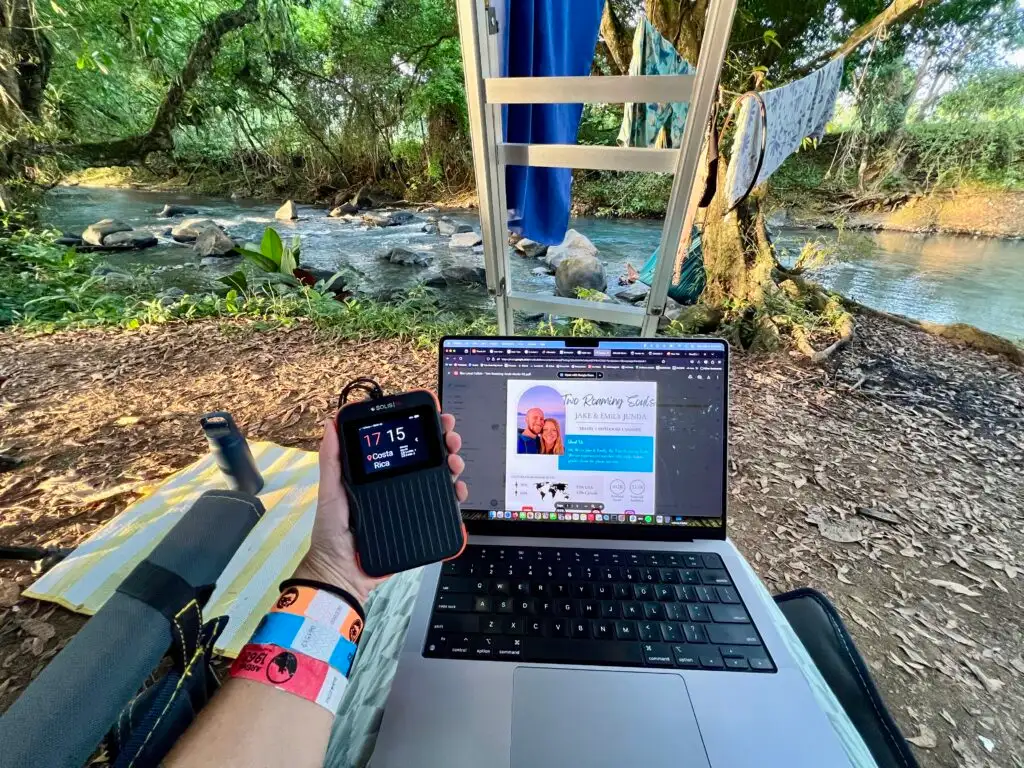
Money
The currency in Costa Rica is called Colones. But in touristy areas, US dollars are used almost just as much, if not more than colones. And nearly everywhere we went, they accepted credit cards.
We did take out some Colones from an ATM at the beginning of our trip, which I do recommend having some on hand for smaller purchases in more rural areas or the occasional tipping money.
But again, I think like 90% of all of the purchases we made were with credit card or payed in advance online.
Gas
Obviously driving a car all over Costa Rica you are going to need to fill up with gas. And at least compared to our home country, the United States, gas is quite expensive in Costa Rica.
Cost per liter is 692 colones/ liter, which is equivalent to $1.37/ liter or $5.19/ gallon.
And Nomad America told us the Jimny needs the higher grade gas called Super.
Luckily, all gas stations are full-service in Costa Rica. So they told me just to say ‘Full Super’, and every attendant understood to fill it up with Super.
But all-in-all, driving all over the country for two-weeks, we spent around $148 on gas. But their larger vehicles would certainly consume more gas.
Internet
When it comes to staying connected, this is definitely the kind of trip that you are going to want cellular data. With all the driving between remote destinations, being able to get directions and look things up on the go is essential.
Most restaurants and other attractions we visited had Wifi available, which helps fill in the gaps, but doesn’t help you much when you’re on the go. Some campsites had Wifi, but I would say that most didn’t.
So the thing we used for cellular data for this trip is the Solis 5G. A device that acts as an all-in-one cellular hotspot.
But other options are E-SIMs (<- learn more from our helpful guide), physical SIMS, or roaming with your home cell phone provider. Which I would rank in that order. Buying E-Sims from a company like Sim Local, Maya Mobile, or Airalo is a pretty easy and cost-efficient way to get cellular data abroad.
Dry Season Vs Rainy Season
This is a very popular discussion topic about Costa Rica. The dry season from November to January has less rain and more sunshine. And wet season is from May to October.
You might be tempted by the cheaper prices and fewer crowds during rainy season. And Nomad America is no different, they offer a 33% discount during the rainy season. But especially when tent camping, rain can be a huge detriment to your overall enjoyment.
Our trip took place from April 30th to May 16th 2025, and May is basically the beginning of rainy season, or really could be described as shoulder season before the true rainy months arrive.
Now, before our trip, we looked up a 10-day forecast that basically put us into a panic. It showed like 70%-100% rain and thunderstorms everyday. But we learned that weather apps and forecasts are basically useless for Costa Rica. And in actuality the weather on our trip was nothing like that.
Costa Rica has very unpredictable and hyper-localized weather patterns. So it can be dumping rain a few miles away and beautiful sunshine where you are.
Even in Rainy season, the weather is still often sunny in the morning, becoming more cloudy as the day goes on, with a good chance of some rain in the afternoon. I would say that most of our trip followed that pattern. Which gave us enough time most mornings to do outdoor activities with decent weather.
But we definitely did encounter some rain and thunderstorms. Some just light sprinkles, and some heavy rains and intense thunderstorms.
I will note, the rooftop tent from Nomad America held up very well in heavy rain storms. We never got wet inside. But some heavy rainstorms did lead us to getting hotel rooms, just so we didn’t have to sit inside the car or tent for the remainder of the afternoon/evening.
But overall, since weather is such a big factor when camping. I would recommend doing this trip during the dry season from November to January. Lack of rain, and slightly less humidity will make a difference in your overall experience.
Some Possible Negatives About Camping In Costa Rica
Now, we want to cover some of the aspects of this trip that were not as ideal.
Tropics Are Hot & Humid
Camping in the tropics always seems like a divine idea. Until you do it and realize that there are some distinct challenges. For starters, year-round it is just hot and humid in Costa Rica. Which makes sleeping in a tent without AC quite uncomfortable.
Luckily, Emily thrives pretty well in hot weather. But honestly, I think I would have slept half as much if it wasn’t for the fan that Nomad America provided.
The only places that offered a little relief from the heat was in the mountainous areas. Places like Monteverde are at 1,300 meters (4,200ft) and actually offer some cooler nights for more comfortable sleeping.
And the other factor about camping in the tropics is the bugs, soooo many bugs. Honestly, we didn’t find the mosquitoes to be that bad (during early rainy season), but there were also no-see-ums, and flies to contend with.
But the real terrorizer was the stinging ants. A few times, even at paid campsites, we parked on top of stinging ants, and even just one of them is a painful burning sensation. And if you’re ever not paying attention and you get stung by several it feels like your foot is on fire.
Paid Campsite Facilities Were Pretty Gross
Paid campsite facilities were often pretty gross and in poor condition. Unless it’s brand new, there’s gonna be dirt, mildew, and bugs. Which half of the blame could be just attributed to the climate. Hot and moist weather just makes it hard to keep facilities looking pristine. But I think campground hosts could have kept up with cleaning slightly better.
Paid Campgrounds Are Expensive
Camping is a little overpriced compared to cheap accommodation. For example, with two people, some campsites would cost us $30 per night. And when you are able to find some cheap hotels and vacation rentals for like $45 per night, to sleep in a real bed with air conditioning and a private clean bathroom. We just felt that paid campsites were pretty significantly overpriced.
Wild Camping Didn’t Feel Safe
But contrary, wild camping didn’t feel as safe. It isn’t like sanctioned dispersed camping areas like what we are used to, here in the western U.S., but rather wild camping was just random spots. So sometimes you didn’t know for sure if you are welcome to be there. Which is especially uneasy if you are in a tent.
Lack of Daylight
Because of Costa Rica’s proximity to the equator, there are only 11.5 and 12.5 hours of daylight per day, year-round. So, sunset is very early. And for safety reasons, we always wanted to get to our campsite before dark.
So we often had to end our days short. Which made us shift our schedule to waking up around 5am every morning. We just felt it was harder to do anything at night if we weren’t parked at a campsite within walking distance to town.
Packing Was Like Tetris
This is mainly an issue because we booked the smaller car, but packing the car everytime was like a game of Tetris. So if you have a lot of stuff, or want to have a little more space to be organized, I’d recommend upgrading to the medium or large rig just for sanity’s sake!
Always Worried About Theft/Robbery
The last thing that we disliked is that you can never really stop worrying about your stuff being stolen. You know how they always say ‘don’t leave valuables in your car‘ at a trailhead, welp, that is pretty difficult when you are just traveling in a car camping rig.
Emily and I basically just resolved to carrying all of our valuables with us at all times. Which definitely gets old after a while. Consider taking a bunch of heavy electronics on every trail to every restaurant and more. (But we have excessive cameras and laptops as creators. You might be able to bring much less on your trip.)
And you need to be sure you have ways to keep your stuff dry if you get caught in a rainstorm. Also, we did find some, what I thought were pretty clever hiding spots in the Suzuki Jimny. Probably don’t want to share them with the entire internet, but if you send us a DM on Instagram, well share our tips!
Also, one other minor note, if you are envisioning this as a surf trip. I don’t know how I could really feel that safe leaving everything in the car if I couldn’t see it.
Things We Loved About Overlanding With Nomad America
Okay, but enough negativity, here are some of the awesome things about camping in Costa Rica with Nomad America.
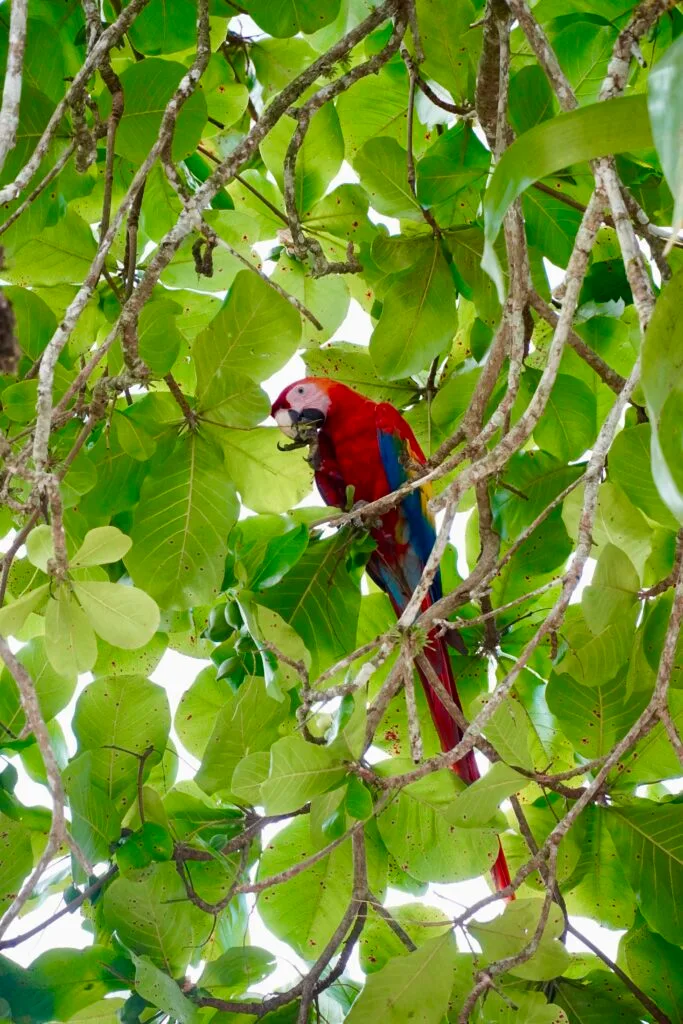
Seeing Wildlife
Since you are living outside most of the trip, your chances of seeing wildlife is much higher than if you stayed in a hotel or vacation rental. We’d often just be sitting outside and hear Toucans or Scarlet Macaws. Or a coati running across the road next to our camp! And if you have a good eye for sloths, there’s a good chance they are amongst the trees you camp near.
Tents Are Better At Keeping Bugs Out
This one might seem a little counterintuitive, but I think tents are even better at keeping bugs out than a hotel room. We have stayed in plenty of hotel rooms in the tropics, and bugs seem to find their way in. But if you are good about keeping the tent screen doors closed, then the tent can actually be your one safe haven from bugs.
Saving Money With Cooking Your Own Meals
With renting a Nomad America Rig, they provide you with everything you need to cook your own meals. While local sodas were pretty inexpensive, more touristy restaurants could be pricey. And that can add up quickly if you eat out 2 or 3 times a day. So it can be nice to grab some local groceries and make your own meals.
Most Affordable Accommodation
Overall, I do think camping is the most affordable type of accommodation in Costa Rica, except for maybe Hostels. And what’s awesome is you are getting a 4×4 rig, your accommodation, and a kitchen all in one rig. Plus the freedom to explore at your own pace and off the beaten path.
Get To Camp At Some Epic Locations
Some of the locations we got to camp in our Nomad America Overlanding Rig were million-dollar views. While sure, you can get these views from hotels or vacation rentals, usually, places with these views are on the higher end of accommodations.
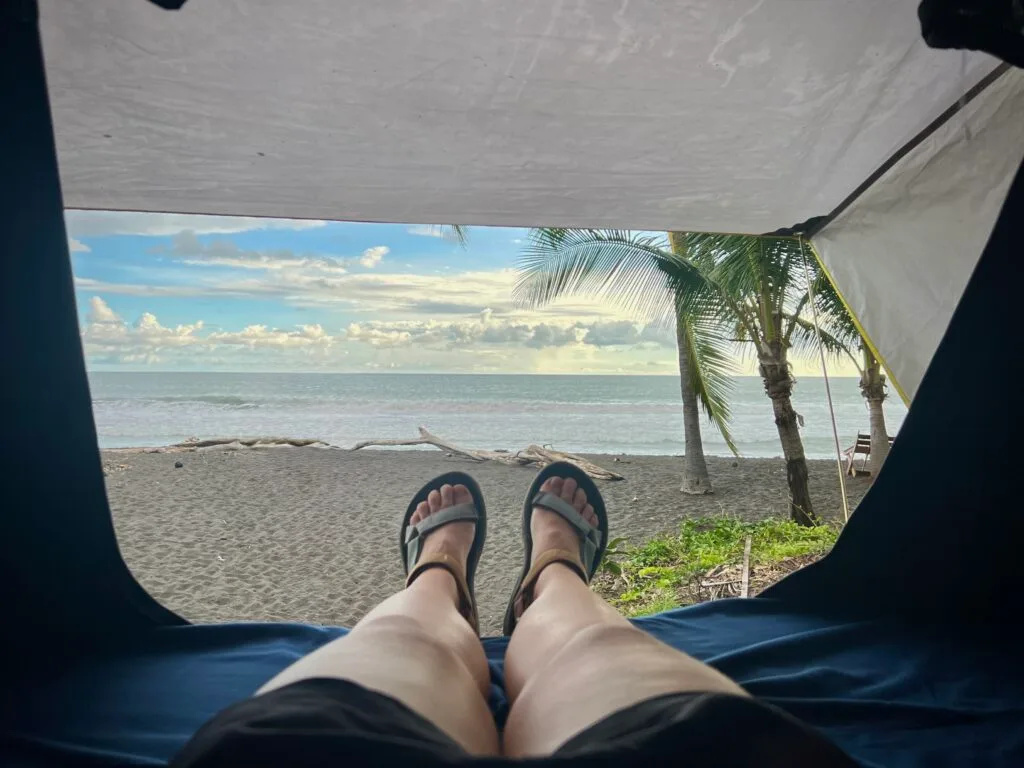
Tips For Camping In Costa Rica
Here are some helpful tips to help you have a successful camping adventure in Costa Rica.
- Bring an Eye Mask and Ear Plugs. The noises of the rainforest at night can be very loud, and having earplugs can help quiet the noise. And sometimes bright lights are left on at some campgrounds, so it can be nice to have an eye mask or for catching a few extra zzz’s in the morning.
- Remember to try to get an early start on your first day, especially if flying in that morning.
- Many people said that Waze is more accurate than Google or Apple Maps. But we used Google Maps and had no problem.
- We found it to be hotter and more humid by the beach than in the mountains. And it at least cools off at night in the mountains.
- During rainy season, everything is less busy. (The shoulder seasons can be great for saving money, but still having decent weather!)
- Book your campsites in advance. (We didn’t book anything before traveling, and while you can often message hosts on WhatsApp and get a quick reply, it often left us stressing about where to stay for the night).
Cost Of A Nomad America Rental
We want to mention the cost of a Nomad America Rig, compared to renting a car and getting a hotel room.
Something to note is that you may see rental cars advertised as super cheap, like $6 per day, but with Costa Rica’s mandatory liability coverage, the price skyrockets! Check out this Costa Rica Guide’s blog about car rental add-on prices.
Cost Breakdown For Nomad America (Suzuki Jimny for 16 Days)
- Suzuki Jimny = $1234.20
- Insurance: (Collision & Liability) $379.89
- Cleaning Fee: $30
- Tax: = $213.74
- Total: $1857.83 (Cost per day = $116.11)
+ Campsite Costs (about $15-30/night)
Overall Cost per day for Nomad America + Campsites: $131-$146
Rental Car + Hotel/Vacation Rental
- 4WD Rental Car (with insurance) = $1538.36 (16 days)
- Cost Per Day = $96.15
- Hotel Costs: $50-100+
Overall Cost per day for Car Rental + Hotel: $146 – $196
Therefore, you can see that it’s a little cheaper to rent an overlanding rig with Nomad America. But the price is rather similar. So you will need to decide if having a camping trip in Costa Rica is something you want to do.
Was Our Overlanding Trip In Costa Rica Worth It?
Overall, YES, we had an amazing trip. But certainly with some highs and lows. And we’re just blown away by the amount of natural beauty in Costa Rica. From the landscapes and insane amount of wildlife to the restaurants and culture.
But as full-time van lifers with lots of camping experience, I think we were prepared for what this trip would bring. We are very comfortable with the challenges of camping, driving sketchy roads, and being okay with not even knowing where we are going to sleep that night.
And from what I discussed before about the cost of paid campsites versus cheap hotels. It’s not like you are saving a bunch of money by camping. So I think it’s got to be an experience that you truly want to have.
Save This Post For Later
